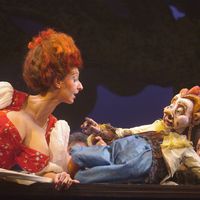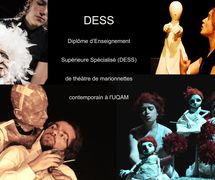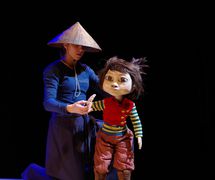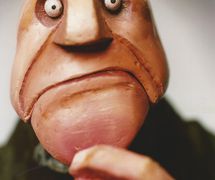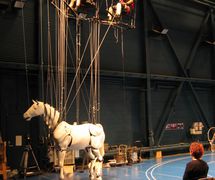Located in the extreme north of [North America], Canada is bordered to the south by the [United States of America], extends northward to the Arctic Ocean and spans from the Atlantic to the Pacific Oceans. Canada consists of ten provinces (Alberta, British Columbia, Manitoba, New Brunswick, Newfoundland and Labrador, Nova Scotia, Ontario, Prince Edward Island, Quebec, Saskatchewan) and three territories (Northwest Territories, Nunavut, and Yukon), which were inhabited for millennia by various Indigenous peoples. The official languages of Canada are English and French, with a number of recognized regional languages. Today, Canada is one of the world’s most ethnically diverse and multicultural nations.
Puppetry in Canada
The first puppets in Canada came from the traditions of Native American and Inuit cultures (see [Native American Puppetry]). Carved, moveable figures were used for religious and ceremonial purposes. Examples of puppets from this rich tradition are preserved in the Museum of Anthropology, University of British Columbia, in Vancouver, at the Royal Ontario Museum in Toronto, and at the British Columbia Provincial Museum in Victoria.
In Quebec City, Jean Natte, known as “père Marseille” (father Marseille), founded a permanent theatre in 1775 that ran until the late 1830s. In the 18th and 19th centuries, the puppet theatre activity in the English-speaking provinces was mostly that of [itinerant troupes] of touring performers from the United States or abroad. The popular tradition of the “bonhomme dansant” (little dancing man, also called a [jigging puppet]) was essentially a performing toy that was “born” in the logging camps in the mid-19th century. When the clergy prohibited dancing, this carved figure defied the ban with a lively clog dance as the animator moved the wooden board upon which it stood. Canada has not developed a traditional puppet character that is unique to the country, such as [Punch] or [Guignol]. It is not until the late 1920s that the history of the modern puppet theatre in Canada begins.
During the late 1920s and throughout the 1930s there were few professional Canadian puppeteers. Among those were David and Violet Keogh in Toronto, Muriel Heddle and [Rosalynde Osborne Stearn] in Montreal. All had established links with the United States and sometimes performed there. Marionettes ([string puppets]) were the principal style of puppetry with the occasional use of [glove puppets]. In the 1930s and 40s, puppetry in Montreal began to develop following the 1933 visit of Vittorio Podrecca and his [Teatro dei Piccoli]. Just after World War II, Hal and Renee Marquette of Toronto were appearing on American [television] with their marionettes and [shadow] puppets, and in Quebec [Micheline Legendre] launched her theatre, Les Marionnettes de Montréal, in 1948.
The Institutions
In the 1950s, the performing and visual arts began to play a truly important role in defining Canadian national identity. This was aided considerably by the establishment of the Canada Council for the Arts, the subsequent provincial arts councils, and the introduction of television. George and Elizabeth Merten arrived from Great Britain in 1950 and helped to launch a boom in educational and recreational puppetry. George Merten (1914-1981), born in England but settled in Ontario, Canada, was the first of three Canadians elected to serve as president of [Puppeteers of America]; he established a puppet programme for the Community Programs Branch of the Ontario Department of Education which lasted almost twenty years. This involved several thousand adults in over two hundred communities in the province. George Merten is the author of Plays for Puppet Performance.
Merten’s work led to the founding of the Ontario Puppetry Association (OPA) in 1957. The Toronto-based association was a focal point for puppet performances, workshops at all levels and was recognized for its collection of international and Canadian historical puppets. When the centre fell victim to funding cutbacks, the OPA collection was donated to the [Canadian Museum of Civilization], located in the Hull area of Gatineau, Quebec, where it has been displayed and preserved. The Ontario Puppetry Association remains the provincial association for puppetry in Ontario and continues to be an advocate for the art of puppetry in the province.
Starting around 1954, there was strong Canadian participation in the United States organization, Puppeteers of America (or PofA, the US association founded in 1937). The national festival of Puppeteers of America was held in Waterloo (southern Ontario) in 1967 and in Vancouver (British Columbia) in 1986. Luman and Arlyn Coad of [Coad Canada Puppets], [Ronnie Burkett] and Ann and David Powell of [Puppetmongers Theatre] have been honoured with the Puppeteers of America President’s Award.
UNIMA-Canada, founded in 1969 in Toronto, was an active centre until the early 1980s. AQM (Association Québécoise des Marionnettistes – Quebec Puppetry Association), founded in 1981, became in 1986 the official centre of UNIMA-Canada. AQM organizes workshops, conferences and published, until 2006, a bulletin, Marionnette en manchette.
During the 1950s and 60s, puppetry evolved in terms of variety and quality. Ken McKay (b.1932) has been involved in many aspects of puppetry since the 1950s. He helped establish the Ontario Puppetry Association. He was a member of the [UNIMA] International Executive Committee and served two years as president of Puppeteers of America. He is the author of Puppetry in Canada: An Art to Enchant (1980), an important reference on the recent and past history of puppetry in Canada. Nancy A. Cole (1936-1996) was an accomplished puppeteer from Ontario. In the late 1980s, puppetry led her into a career as a creative arts therapist. This culminated in her book, Lend Them a Hand –Therapeutic Puppetry (1993; see [Society and Puppets – Social Applications of Puppetry]). Quebec puppeteer [Felix Mirbt] for many years integrated puppetry in a most imaginative way in several English-language, large-scale theatre productions. Pierre Régimbald and Nicole Lapointe formed a company in 1964 using hand ([glove puppets]) and [rod puppets] (see [Régimbland]).
Alongside Canadian puppeteers, puppeteers from Great Britain, France, Germany, the Netherlands, Japan, Czechoslovakia, Hungary, Australia, Russia and the United States settled in Canada and all contributed to the development of Canadian puppetry. Since 1966, Vancouver (British Columbia) has been the home of Coad Canada Puppets (Arlyn is from Britain and Luman Coad was originally from the United States). They are recognized in puppetry circles throughout the world for their high quality, artistic, live performances with marionettes and hand (glove) and rod puppets. In 1968, Dora Velleman (1916-2011) and Leo Velleman (1917-2009) formed their company, Canadian Puppet Festivals. In 1972, both the Vellemans and Coads performed at the Festival Mondial des Théâtres de Marionnettes in Charleville-Mézières, France.
Television and Puppets
The high quality and supportive creative climate in television studios of Toronto and Montreal has been a training ground for puppeteers (see [Television]). John Conway (1922-2003) was, in 1952, the first puppeteer on the CBC (Canadian Broadcasting Corporation). John and Linda Keogh, second-generation puppeteers, also stand out as pioneers on television and their daughter, Nina Keogh, continues the tradition. French-language broadcasting began in 1952. In 1960, Michel Cailloux created the character of Bobinette who made history by appearing daily for twenty-eight years on the show Bobino. In 1977, Pierre Régimbald and Nicole Lapointe began their television career with Passe-Partout, whose characters and adventures are still known to children in 2011. They also created Nic et Pic, which was very popular in the 1970s.
The international importance of Canadian television puppetry is evident in the fertile exchange of talent between Canada and neighbouring United States. Leo and Dora Velleman, present on CBC since 1953, worked for a time in the United States before returning to Canadian television in 1962. The Friendly Giant began in the United States and soon became a Canadian hit. The show that became Mister Roger’s Neighborhood in the United States began in Canada in 1962. Ernie Coombs (1927-2001, American) and Judith Lawrence (Australian) began Mr. Dressup in 1964. Nancy Cole is another Canadian known for live and television work on both sides of the border. Nikki Tilroe (1941-2005) and Robert Tilroe (of Frog Print Theatre) moved to Toronto in 1968 and did both live and television puppetry for fifteen years before returning to the United States. Since 1970, [Noreen Young] has been involved with over one hundred television programmes, including the award-winning series, Under the Umbrella Tree (1986-1993).
The excellent quality and lower production costs of Canadian television attracted [Jim Henson] to Toronto in 1968 where the first [Muppet] television special programme was produced. After the American success of Sesame Street, a Canadian version was produced and re-named Sesame Park in 1988. Another Henson success, Fraggle Rock (1983-1986), began production in Toronto. Robert Mills worked with the Muppets and founded Radical Sheep Productions, the producer of Big Comfy Couch (1993), seen by children around the world. Radical Sheep produced the highly adult Puppets Who Kill (2002), created by John Pattison and Steve Westren who both worked for Jim Henson. Fred Stinson, Ron Stefaniuk and Frank Meschkuleit are all part of Toronto’s thriving television puppetry in English-speaking Canada.
The 1970s
The 1970s saw a real explosion in the art of puppetry. This was a time of significant government support for Canadian puppetry. Within a few years several companies of international renown were established. In Nova Scotia, the [Mermaid Theatre], founded in 1972, continues to integrate many styles of puppetry and masks into their imaginative theatre productions of Canadian stories which they have toured throughout Canada and the United States. In 1972, the [Lampoon Puppettheatre] began working, and today Johan Vandergun continues to perform in Canada and internationally with productions incorporating many styles and techniques. This company has been a Canadian presence at over sixty international [festivals] in more than twenty-five countries. In 1974, Diane Dupuy began [Famous People Players], a company that uses life-size puppets and fluorescent props manipulated under ultra violet light (see [Black Theatre]). Since its inception it has dazzled audiences throughout North America and Asia. David and Ann Powell, of Puppetmongers Theatre, have, since 1974, incorporated [tabletop puppetry] manipulation “[bunraku]-style” and [object theatre] into their theatrical, witty productions. In 1996, the Powell’s began a school of puppetry, offering short courses for adults. From 1975 until they retired in 1982, the Vellemens directed Leading Wind as a permanent puppet theatre in Chester, Nova Scotia. Chris Hurley created the Manitoba Puppet Theatre in 1975. The Rag and Bone Puppet Theatre, of John Nolan and Kathy MacLellan, began operating in Ottawa in 1978. The same year, David Smith Marionettes, based in Kingston (Ontario), began his long career entertaining young audiences.
Quebec Puppetry
In the 1970s, Quebec experienced its own explosion of puppetry. Quebec can pride itself on the large number of first-rate puppeteers and companies whose distinctiveness has made a significant contribution. The excellence and perseverance of the companies of the 1970s won the support of governments and cultural institutions. As a result, most of these companies have survived to this day.
[Théâtre Sans Fil] (founded in 1971) uses [giant puppets] and imposing stage scenery. The company has acquired a national and international reputation. [Théâtre de l’Œil] (founded in 1973) has charmed young audiences and critics alike with the subtlety of its subjects and its clever method of combining various [manipulation] techniques and integrating them with inventive [scenography]. Josée Campanale started her work at the Grand Théâtre de Québec in 1974. Praised for the intelligence and enchanting beauty of her scenography, in 1993 she created her own company, [Théâtre de Sable]. Another company, [Théâtre de la Dame de Coeur] (founded in 1975 by Richard Blackburn), uses oversized puppets and presents impressive outdoor productions.
Michel Frechette began teaching puppet courses in the mid 1970s at the Université du Québec à Montréal (UQAM, Quebec University in Montreal), and around the same time established [Théâtre de l’Avant-Pays] which explores the interaction between actor and puppet. Trained at the Prague University (Czech Republic), Claire Voisard, co-founder of [L’Illusion, Théâtre de Marionnettes] (founded in 1979) and colleagues convert texts from world literature into images, creating shows that combine ingenuity and fantasy. The company [Théâtre Les Amis de Chiffon] (founded in 1974 in Alma, Saguenay-Lac St-Jean, a region of the Province of Quebec) works far from the major metropolitan centres, introducing puppetry to a vast public in the province’s regions. The company is well known for its tours around Quebec and the rest of Canada.
In the late 1970s and early 1980s, other excellent teams formed companies: Les Trois Petits Tours, Théâtre de la Rue, La Bastingalle, Centre Populaire de la Marionnette au Saguenay, Le Théâtre Mille Tours. Then, with the changing economy, companies emerged with only one or two persons – Les Marionnettes du Bout du Monde, Claire et René, Le Matou Noir, Gestes Théâtre, Magda Harmignies, Théâtre Biscuit, Théâtre de Zef – but would later expand their personnel. However, other than Gestes Théâtre of Diane Bouchard and Les Marionnettes du Bout du Monde, these companies have since disappeared.
In the 1990s, some Canadian puppeteers withdrew from the large companies to create their own groups. These artists include Jacques Boutin, Marcelle Hudon, Motus. In addition, a new generation of actors and puppeteers joined forces to form creative groups to produce shows for adults: Pupulus Mordicus, Théâtre du Sous-Marin Jaune, Théâtre Incliné. Younger companies, like Soma, Kobol Marionnettes and Les Sages Fous, engage audiences outside of Quebec with their successful tours abroad.
Since 1990, a new international event, initially called the Semaine Mondiale de la Marionnette and later renamed Festival International des Arts de la Marionnette à Saguenay, has been held in Quebec. This biennial festival that runs for ten days in Saguenay hosts prominent companies from around the world.
The 1980s and 1990s
All over Canada the on-and-off funding from the government first stimulated growth and then required puppeteers to find new strategies to survive. The creation of new theatre festivals has created a wider more diverse audience for puppetry. In Vancouver in 1977, an international festival of children’s theatre was founded. Similar festivals developed all over Canada providing venues to showcase high quality puppet theatre. In 1982, the Edmonton Fringe Festival was the first of many such festivals to provide opportunities for young, experimental artists to perform.
[Ronnie Burkett], now in Toronto, began his career in Alberta entertaining adult audiences with his one-person marionette performances, usually saucy and risqué. The Ronnie Burkett Theatre of Marionettes, founded 1986, has taken the art of puppet theatre to new expressive heights and has earned Ronnie Burkett many awards and international acclaim.
Robert Lepage founded the theatre group [Ex Machina] in 1994. The internationally recognized director of theatre and [opera] sometimes uses elements of puppetry such as his 2011 production of Igor Stravinsky’s Nightingale and Other Short Fables. Another company, Soma, founded in Montreal in 1999 by Serge Deslauriers and Enock Turcotte, produced Cabaret Decadanse which has played around the globe.
The Maritime Marionettes perform across Nova Scotia with their colourful shows.
In 1986, Woolfe Eldritch founded a theatre company in Toronto using puppets and masks to create darkly comic presentations. Wendy Passmore is very active in Calgary. The [Bread and Puppet Theater] (United States) has inspired the founding of several Canadian companies that use giant-sized pageant-style puppets, including Shadowland Theatre of Anne Barber and Brad Harley based in Toronto since 1983, and Clay & Paper Theatre, directed by David Anderson, who has been performing in Toronto public parks since 1994. Jumblies Theatre, founded by its artistic director, Ruth Howard, has been using community participation for its works since 1998.
Since 2000
The ongoing work of its associations – AQM (Quebec Puppeteers’ Association) and the OPA (Ontario Puppetry Association) –, the establishment of new festivals, and a new university [training] programme contribute to the dynamic development of the profession. This activity has resulted in the arrival of new puppeteers and the creation of new companies. Thanks to the dynamism of programmers who promote the work of young artists, people see the possibility of a career in puppet theatre.
Puppetry [cabarets] or “slams”, which are usually associated with puppet theatre in the United States, have also developed in Canada. Given their open format, “slams” encourage experimentation, and many emerging artists, especially in Toronto, are finding them to be the most supportive place – and sometimes the only place – to present their work. Puppetmongers, Unraku, and Quality Slippers Productions are among the companies presenting these exciting events.
The Old Trout Puppet Workshop was established in 1999 in southern Alberta. Its founding members sought to focus on a style of puppet theatre where fragility, softness and sometimes ridicule play next to gravity and drama. They sculpt their puppets and, from their first show, they have received positive responses from their audiences. The company’s collective process of creating new work has been carefully watched by the field. The Banff Center for the Performing Arts, a recognized institution in arts and culture training, regularly programmes the Old Trout as workshop facilitators.
In Calgary, the biennial International Festival of Animated Objects promotes the arts of puppetry, mask, and animated objects. The festival’s programmes have presented Canadian companies such as Ronnie Burkett and Puppetmongers Theatre from Toronto as well as international companies.
In Almonte, Ontario, in 2004, the Puppets Up! International Puppet Festival was established by [Noreen Young], a pillar of Canadian puppetry. The festival is primarily intended for family audiences.
In Quebec, Le Théâtre de La Pire Espèce, directed by Francis Monty, Olivier Ducas and David Lavoie, use [object theatre] and raw material in a panorama of puppetry techniques now used by other artists and companies. The company is one of the founding companies of the new theatre for young creators in Montreal, Aux Écuries.
In Trois-Rivières, South Miller, Jacob Brindamour and Sylvain Longpré created the company, Les Sages Fous. Their street performances and creations, imagined through various public experimental works called “research laboratories”, are performed in Canada and at major international puppet festivals. In 2002, they created The Micro-Festival of Unfinished Work in Puppetry, an event during which young companies and artists from Canada and abroad can test their works-in-progress.
Théâtre Motus, directed by Hélène Ducharme and Sylvain Massé, creates notable work inspired by traditions from cultures around the world. Théâtre Incliné and Pupulus Mordicus are now mature companies that develop teen and adult puppet theatre. Pupulus Mordicus sets itself apart with the training opportunities it offers.
Many Canadian puppeteers continue to offer their services to [television] puppetry and are a driving force for new television programming. Interdisciplinary artists create hybrid performances, combining puppetry, technology, [shadows] and mask. Artists from various disciplines, such as dancers, visual and multimedia artists, join these creative teams. Marcelle Hudon, an exceptional artist whose work is highly appreciated by her peers, is a part of this collaborative interdisciplinary movement. Other interesting artists and companies include Mobile Home, Clea Minaker, 2boys.tv, Zal Zone Artistique Libre, and Les Filles Électriques.
Scenic designers and puppet designers now working in the field include Richard Lacrois, Jean-Guy, Patrick Martel, Marie-Pierre Simard and Mathieu René. Passionate young artists trained in companies or through available training programmes have founded companies, including Puzzle Théâtre, La Tortue Noire, Qui va là, Théâtre des Petites Âmes, Le Théâtre de Deux Mains, Mr. Bunk, l’Ubus Théâtre, and La Tête de Pioche.
In 2006, Louise Lapointe established Casteliers in Montréal, a team whose mission is to facilitate the touring of puppetry arts and whose main activity is the festival, Les Trois Jours de Casteliers. This event stimulates creativity with the quality of its programming of national and international companies
In 2007, the École Supérieure de Théâtre de l’Université du Québec à Montréal (UQAM) established a new [training] programme. The DESS (Diplôme d’Études Supérieures Spécialisées) in contemporary puppet theatre is directed by Marthe Adam. It is the only ongoing training puppetry programme in Canada. Over a period of two years, students follow various classes including acting with a puppet, stage design, puppet building, directing and writing for puppetry. National and international artists are invited to teach in the programme. Casteliers, l’École Supérieure de Théâtre and AQM collaborate to realize common projects.
In 2010, the two existing Canadian puppetry associations, AQM and OPA, met to restore [UNIMA]-Canada as an organization that would represent both regions with the creation of two sections: Section Quebec and Section Ontario. Section Quebec, active during the previous twenty-five years under the umbrella of AQM, has been a driving force for the arts of puppetry with training opportunities, meetings, an annual publication, and an up-to-date website. In 2011, the first assembly reuniting the two sections was held. One of the principal objectives of UNIMA-Canada is to share resources and expertise and to generate mutual projects.
Contemporary Directions
In the second decade of the 21st century, Canadian puppet theatre is expanding the field by integrating various art forms into its creations. Authors are joining creative teams and a repertory of written work is emerging. Young directors employ advanced digital technology for both live theatre and for presentations on the Internet. The dynamic energy of these projects includes the collaboration of experienced artists and younger creators as Canadian puppetry continues to re-invent itself.
(See also [Jacques Trudeau].)
Bibliography
- Adam, Marthe. “Québec: un développement fulgurant”. Les Carnets de la marionnette. Themaa, France: Éditions théâtrales, 2006.
- Adam, Marthe. “Le DESS en théâtre de marionnettes: de l’écriture à la scène”. Revue Jeu. Montréal, 2011.
- Adam, Marthe. “Le DESS en théâtre de marionnettes contemporain; un essor fulgurant”.
- Revue Marionnette. Montréal: Publication de l’Association québécoise des marionnettistes (AQM), 2011.
- Adam, Marthe. “A new training in Canada”. Revue Puppetry International. États-Unis, 2011.
- Adam, Marthe. “Heyday of vocational training”. Revue Teatr Lalek. Pologne, 2012.
- Canadian Theatre Review. No. 95. Guelph (ON): Univ. of Toronto Press, Summer 1998.
- Fréchette, Michel. “La Marionnette au Québec: histoire et réalité”. Jeu Montréal. No. 51, June 1982.
- Legendre, Micheline. Marionnettes. Art et tradition. Montréal: Leméac, 1986.
- McKay, Kenneth B. Puppetry in Canada. Willowdale (ON): Ontario Puppetry Association, 1980.
- McPharlin, Paul. The Puppet Theatre in America: A History, 1524-1948. Boston: Plays Inc., 1949; With a supplement, Puppets in America Since 1948, by Marjorie Batchelder McPharlin. Boston: Plays Inc., 1969.
- Powell, Ann. Professional Canadian Puppet Theatre Companies. A Partial Listing. Self-published, 1988.
- Puppetry Journal. Vol. 40, No. 1. Fall 1988, Puppeteers of America.









